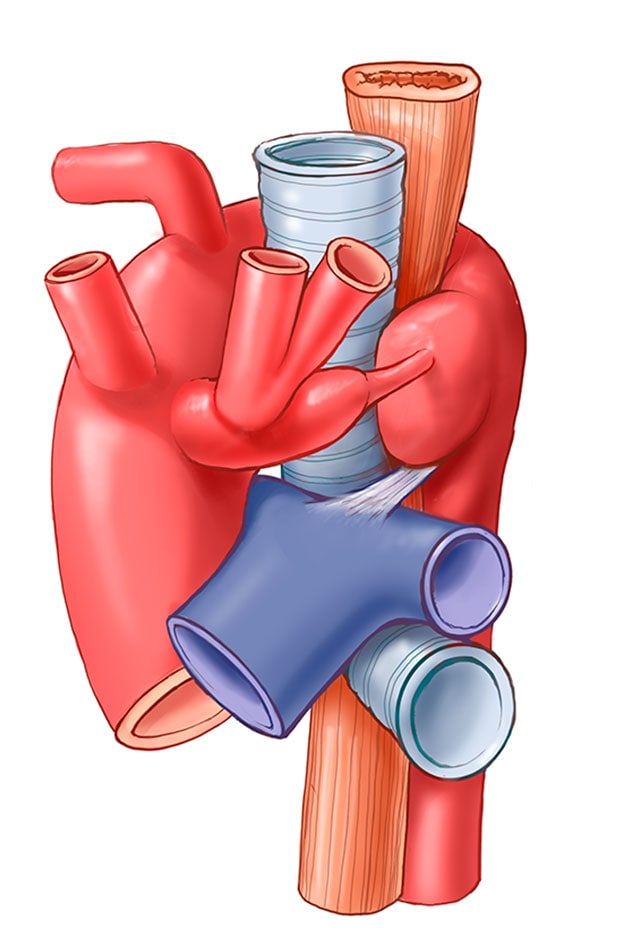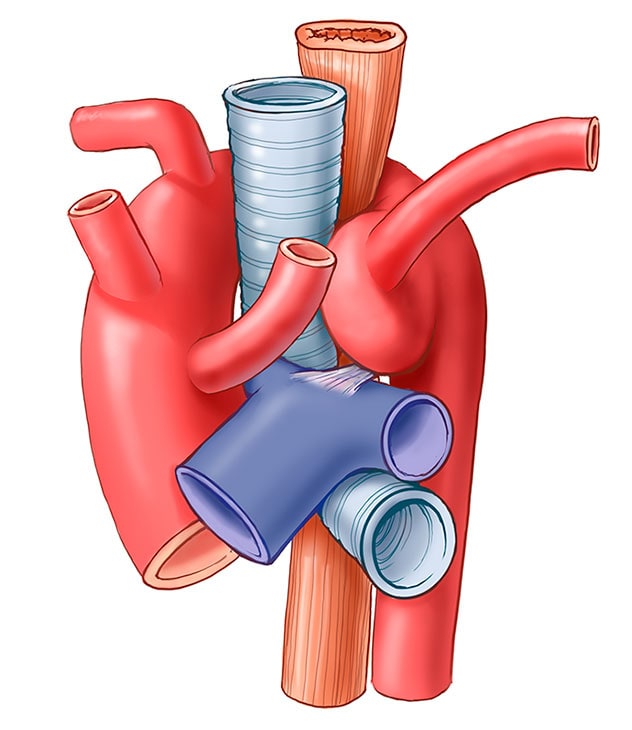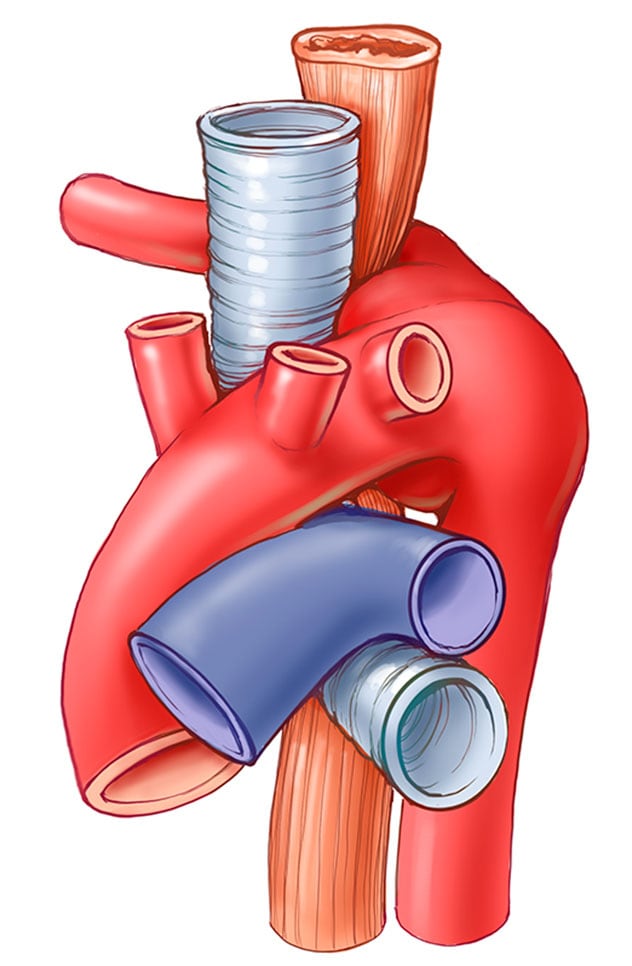March 31, 2022
Vascular rings are a group of diagnoses present at birth caused by abnormal development of the brachial arch system, which results in a ring of vessels encircling and constricting the airway and esophagus. In typical development, specific segments of these brachial arches involute while others remain. When there are abnormalities in this process, various types of vascular rings occur.
双主动脉弓

双主动脉弓
双主动脉弓修复术通常用于婴儿,从侧面(胸部)分开附加的主动脉弓。
右主动脉弓伴左韧带

右主动脉弓伴左韧带
成人右主动脉弓伴迷走左锁骨下动脉需要进行血管手术,通过颈部的切口将锁骨下动脉改道,使其脱离颈动脉。
左主动脉弓伴迷走右锁骨下动脉

左主动脉弓伴迷走右锁骨下动脉
当出现明显症状时,左主动脉弓伴迷走右锁骨下动脉通常通过血管手术进行修复,通过颈部的切口将锁骨下动脉改道,使其脱离颈动脉。
There are a number of different types of vascular rings, with diversity within each type. The most common types are:
- Double aortic arch
- Right aortic arch with left ligamentum, which may also have an aberrant left subclavian artery
- Left arch with aberrant right subclavian artery — technically a sling since it does not form a complete ring
There is no known cause of or genetic link for vascular rings. Symptoms such as difficulty swallowing, difficulty feeding, or wheezing and coughing can appear early in infancy, especially in those with double aortic arch. In other types of vascular rings, symptoms often don't appear until a baby starts to eat solid food, and symptoms may not appear until even later in life. Because symptoms can be subtle and vague, and because children learn to compensate by chewing very thoroughly, preferring soft foods and limiting their activity when short of breath, it's not unusual for the diagnosis to occur much later, even in adolescence or adulthood.
Respiratory symptoms such as frequent colds or inability to clear a cough after a cold are often viewed to be a normal variant, especially for children in child care, delaying diagnosis. Older patients might report eating very slowing and chewing food thoroughly, having a diagnosis of GERD, experiencing breathlessness in sports or having a diagnosis of asthma.
Surgical intervention is nearly always recommended to release vascular rings. The subgroup of left arch with aberrant right subclavian, technically a sling, rarely causes significant symptoms. These patients usually do not need intervention, but there is a select group in which the anatomy causes significant dysphagia.
Steps for diagnosis
Diagnosis of vascular rings requires:
- CT scan, on which a vascular ring would be evident. Frequently the diagnosis of a vascular ring occurs when a CT scan is performed for another indication.
- Echocardiogram to check for any additional heart anomalies.
- Bronchoscopy to look for additional tracheal pathology.
Increasingly, vascular rings are diagnosed during imaging conducted during pregnancy. "With a fetal diagnosis, we have the opportunity to perform surgery much earlier, reducing the deleterious effects of the ring compressing the trachea and esophagus for a longer time," says Elizabeth H. Stephens, M.D., Ph.D., a pediatric and congenital heart surgeon at Mayo Clinic Children's Center.
For the youngest patients, Mayo Clinic Children's Center physicians have developed an algorithm to evaluate risk to patient, best age for surgery, and when birth should occur at hospitals equipped for pediatric heart surgery. Corrective surgery for those with a fetal diagnosis is typically performed when patients are between 6 months and 2 years old.
Surgical interventions
Mayo Clinic pediatric cardiac surgeons are experienced in various surgical treatment approaches for patients of all ages. In infants and young children, surgical repairs often are performed within the chest from the side. In teens and adults, repairs often are performed in two stages, with vascular surgeons rerouting the subclavian artery with a small incision by the collarbone in the first stage and performing the second stage via the chest.
Depending on the specific anatomy, some of these procedures require a heart-lung machine. Surgical approaches include the following:
- Double arch repair is usually done in infants to divide the additional arch from the side (chest). No bypass is required.
- Right arch with aberrant left subclavian in young children is repaired from the side (chest). The subclavian is rerouted by attaching it to the carotid artery, and the ring is released.
- When causing significant symptoms, left arch with aberrant right subclavian is usually repaired via vascular surgery rerouting the subclavian to come off the carotid artery via an incision in the neck and is followed by resection of the residual stump from the side (left chest).
- Right arch with aberrant left subclavian in adults requires vascular surgery rerouting the subclavian to come off the carotid artery via an incision in the neck and is followed by replacing that part of the aorta on bypass from the side (right chest).
Outcomes
Mayo Clinic pediatric and congenital heart surgeons have conducted retrospective studies on pediatric and adult patients who have undergone surgical correction of vascular rings. "We have found that, in general, surgical repairs have excellent outcomes and minimize complications related to chronic airway and esophageal compression," says Dr. Stephens.
For more information
Mayo Clinic Children's Center.
The Mayo Clinic approach to repair of adult vascular ring. Mayo Clinic.
Refer a patient to Mayo Clinic.